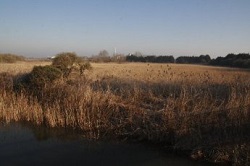Cockoo bridge and reed beds
 Cuckoo bridge is aptly named, as cuckoos can frequently be heard in this area. It is possible that the number of reed buntings and reed warblers attract them as the nests of these species are often used as a foster 'cradle' by the cuckoo.
Cuckoo bridge is aptly named, as cuckoos can frequently be heard in this area. It is possible that the number of reed buntings and reed warblers attract them as the nests of these species are often used as a foster 'cradle' by the cuckoo.
A peaceful place to stop, look and listen, kingfishers may be seen darting under the bridge or at the water's edge. In summer, sedge and reed warblers can also be seen and the area supports many water birds including the tufted duck, gadwall & little grebe, and a number of dragonfly species. Marsh Harriers feed over the reed beds, which were once part of the Roswell workings. Spawning bream may also be seen under the bridge.
Cuckoo bridge provides pedestrian access across the inlet from the river Ouse to Roswell Pits. The current, metal, cuckoo bridge was constructed in 2000, to replace a wooden bridge, much loved, but slippery and leaning at a precarious angle!
Beyond Cuckoo bridge a winding path leads to the steel footbridge over the river Great Ouse and towards the Queen Adelaide Pits. Little ringed plover bred on the marl from the sugar beet factory, which is long since buried under Potter tarmac.
You can hear more about Ely's Wild Spaces at Memories of Ely Pits and Meadows.




